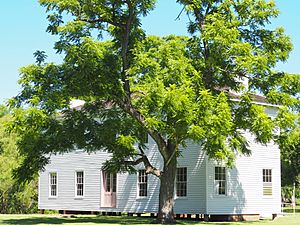Levi Jordan Plantation State Historic Site facts for kids
Quick facts for kids
|
|
|---|---|
| Lua error in Module:Location_map at line 420: attempt to index field 'wikibase' (a nil value). | |
| Location | 7234 FM 521, Brazoria, Texas |
| Designated | 2001 |
| Built | 1848-–1851 |
| Architect | Levi Jordan |
| Architectural style(s) | Greek Revival |
| Governing body | Texas Historical Commission |
|
Recorded Texas Historic Landmark
|
|
| Designated | 1967 |
| Reference no. | 9570 |
The Levi Jordan Plantation is an important historical place in Texas. It is located about 4 miles southwest of Brazoria. This site was once a large farm that grew sugar and cotton. Many enslaved Black people were forced to work here during the mid-1800s.
The plantation was recognized as a Recorded Texas Historic Landmark in 1967. For many years, experts from the University of Houston have studied the history of this site. They have learned a lot about the people who lived and worked there.
Contents
Who Was Levi Jordan?
Levi Jordan (1793–1873) was a farmer from Georgia. In 1848, he moved to Brazoria County, Texas. He brought twelve enslaved Black people with him. Before this, Jordan owned farms in Arkansas and Louisiana. He wanted to build a successful farm that would last for many years.
Jordan bought 2,222 acres of land in Brazoria County. While he was away selling his old farms, the enslaved people he brought worked to prepare the new land. They got it ready for planting and building.
After Levi Jordan passed away in 1873, his land was divided. It went to his grandsons, J. C. McNeill and C. P. McNeill.
History of the Plantation
The Levi Jordan Plantation was built between 1849 and 1851. It included a large family home, living areas for enslaved workers, and other buildings.
The Jordan House
The main house, called the Jordan House, is a two-story building. It was built in the Greek Revival style. This style was popular for grand homes at the time. The house was made with strong yellow pine wood from Florida. The enslaved workers used local oak wood to make window sills and other parts. They also made bricks by hand for the fireplaces.
Farming at the Plantation
At first, sugar cane was the main crop grown here. Levi Jordan built the biggest sugar factory in Brazoria County. Other nearby farmers also used his factory. After the American Civil War ended in 1865, growing sugar cane became difficult.
So, Levi Jordan and his family changed the farm. They started growing cotton instead. Many of the formerly enslaved people and their families stayed to work on the cotton fields. They became sharecroppers, meaning they farmed the land and shared the crops with the owner.
Living Quarters for Enslaved People
The cabins where enslaved people lived were located near the Jordan House. By 1860, more than 130 enslaved people worked on Jordan's plantation. Some of them had been born in Africa. These cabins were used by workers until 1887.
Today, the cabins are no longer standing. However, archaeologists have dug up the area. They found over 600,000 artifacts. These items help us understand the daily lives and history of the people who lived there.
Levi Jordan Plantation State Historic Site Today
The plantation land was owned by Jordan's family until 2001. Then, a group called the Houston Endowment bought 90 acres of the land. In 2002, they gave it to Texas Parks and Wildlife. Now, the Texas Historical Commission owns the site. Texas Parks and Wildlife manages it as the Levi Jordan Plantation State Historic Site.
A local group called the Levi Jordan Plantation Historical Society was started in 1993. This group includes descendants of the people who lived at the plantation. They work to protect and share the site's history.
In 2003, money was approved to help restore the property. The plantation house was restored starting in 2012. As of November 2015, the site is open for tours on Saturdays.
See Also


